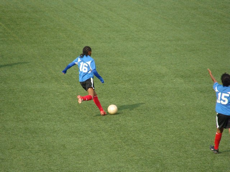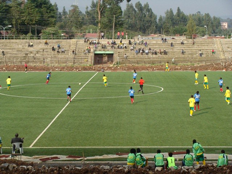
By Martha Saavedra
Martha Saavedra is Associate Director of the Center for African Studies at the University of California Berkeley. Trained as a Political Scientist, she has taught at St. Mary’s College of California, UC Berkeley, Ohio University and the Escuela de Estudios Universitarios Real Madrid. Her research has ranged from agrarian politics, development and ethnic conflict in the Nuba Mountains of Sudan to gender and sport in Africa to a collaborative project on representations of Africa in Chinese popular culture. She has been on the editorial boards of Soccer and Society; Sport in Society; and Impumelelo: The Interdisciplinary Journal of Sports in Africa. A veteran of Title IX battles, she has played soccer for over 30 years and coached boys teams for 12 years.
On Tuesday at the University of California, Berkeley, I attended a panel discussion on Gender for a New Century: Countering Violence and Social Exclusions. The panel focused on important issues that the international community will be addressing in 2015 via United Nations’ assessments of efforts derived from the Millennium Development Goals and the Beijing Platform for Action frameworks. Faculty from UCB raised a number of really important topics including transnational labor markets, migration, sustainability, water & sanitation, disability rights, 2+ genders systems, culturally embedded gender-based violence, economic policy implications, nationalism and education. Phumzile Mlambo-Ngcuka, United Nations Under-Secretary-General, Executive Director of UN Women, the featured speaker, responded to these points and suggested how gender might be addressed given the convergence at the UN of post-2015 MDG and Beijing 20+ discussions. It was an invigorating discussion setting out important aspirations, points of leverage, and boundaries for upcoming high level and impactful debates. Yet, nary was intimated about sport, physical activity, or, that all important endeavor, football.
Earlier that day in the office, before the gender event, a couple of us watched the United Nations sponsored ‘Africa United’ videos on youtube featuring Idris Elba as well as Carlton Cole, Yaya Touré, Andros Townsend, Patrick Vieira, Kei Kamara and Fabrice Muamba. (Also dubbed in Krio and French.) You’ve got to watch them if you love football, and ‘007 Idris, and if you are at all involved in efforts to confront the fears, misconceptions and realities of the current Ebola outbreak in West Africa. Idris says “Its key strength is passing.” How can you not believe? “We are not heroes.” The health workers – “you are the true heroes”. The world’s most important team. Kudos to them. Not much to argue with there. But, of course, the UN does not call upon women footballers to help carry this message.
“Give her a room of her own and five hundred a year, let her speak her mind and leave out half that she now puts in, and she will write a better book one of these days.”
Virginia Woolf, A Room of Ones’ Own, Chapter 5
Pause, tap the ball, swivel, and switch direction.
I’ve struggled to write this piece. Not so much in ways encountered previously when working on academic pieces. Indeed, I have not been sweating over theory, turns of phrases, and proper citations, or more seriously labored to marshal evidence or validate statistics. Instead I’ve simply struggled to find the time and space to put anything on paper – digital or otherwise. Undoubtedly a self-centered assessment, but this state I think may say something about the production and circulation of ‘scholarly’ knowledge about women’s football. While many more are ‘doing’ this, i.e., playing football everywhere, few have the space and time to reflect and write about it let alone disseminate ruminations, a.k.a. research, to an appreciative audience. There are a lack of rooms and the equally important £500 per annum. And the most likely audience is often otherwise busy. Playing, coaching, working, cooking, cleaning, studying, child-rearing, driving, fund-raising, surviving. And yes, attending campus events and watching Idris Elba videos with colleagues.
Switch fields
Nevertheless, the numbers of girls and women participating in football on the African continent in multiple ways are increasing. One goal of mine has been to try to document this phenomenon and expand dialogues around this. Fortunately, there are many scholars younger than I, including Susann Baller, Mari Engh, Nihad el Kayed, Marianne Meier, Beth Packer, Cynthia Pelak and many more who are pursuing this. I am cognizant that the space, time and funding to pursue any serious study of women’s football is seriously circumscribed. Yet, I am ever hopeful that this is changing.
Look up/check in
Women’s football in Ethiopia – This is the topic that I wanted to focus on: Simply stated – there has been a growth in teams and opportunities for women footballers in Ethiopia over the past decade. At the local level, a women’s premier league exists and some teams are able to provide some minimal support for individual players. There are indications of continued interest and growth, including some dissension over recognition of contributions to the women’s game. In ways that may very well be distinctive, the national football federation has supported this. For instance, in 2011, the federation underwrote the women’s national team, Dinknesh (or Lucy), in their bid for a berth at the 2012 London Olympics. Prior to the play-off with South Africa, the Federation footed the bill for two months of training in a special camp for the players. I met with various officials in Addis at the time and was impressed with their commitment and excitement. The team unfortunately lost 0-3 in the first match and drew 1-1 in the second match. This, thus far, has been the high point in international competition for the national team, but the league continues and the federation still seems supportive. Women players may still have to contend with obstacles. Key family members may not be supportive and may even actively oppose participation. General social norms around femininity and gendered expectations still have to be negotiated as do the multitude issues facing youth in Ethiopia. But success breeds support, which breeds success. And the social expectations around football that women face in other parts of the continent do not seem as palpable in Ethiopia.
Field sense
This all too brief overview is just to suggest that there is more work to do in exploring women’s football in Ethiopia I have done some preliminary work scanning the field and considering sources (with an unfinished paper available online), and I hope to do more. Yet, I do not speak or read Amharic. Or Tigrinya, Oromo, Somali or any of the other languages of Ethiopia. Without local language skills, much will be missed. Whether I find the “room and £500” to pursue this or not, I am hopeful that there are others with the right set of skills who will.
Extra Time



Final
Dedicated to Selam, who as far as I know, didn’t play football, but was an inspiration to many.